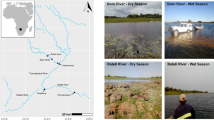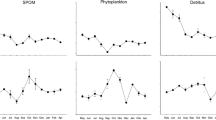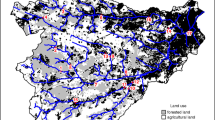Abstract
The river discontinuity caused by damming can modify both the availability of production sources and the energy flow in riverine food webs. We hypothesized the carbon source support food web would vary among the reaches in response to changing in hydrogeomorphic conditions, and this variability further caused food web structure changes. To test our hypothesis, three different river reaches in the lower **sha River, China, were selected and the stable isotope ratios of basal sources and dominant consumers were analyzed in three seasons 2015. The relative importance of basal sources showed temporal and spatial difference to varying degrees. Seston were the most important carbon sources in supporting all consumers and the contributions increased from upstream to downstream. Riparian C3 plants played an important supplementary role in both reaches above the dam or only in the high flow period. Dam-induced flow alteration changed the trophic basis and the composition of food webs, resulting in a difference in the food web structures, and widening but with lowest complexity food web occurred in the downstream reach. The results further confirm that the differences in the hydrogeomorphologic conditions caused by dam construction can exert potential influence on riverine food web structures.







Similar content being viewed by others
References
Anonymous, 1976. Leptobotia elongata. In Fish Laboratory, I. O. H. (ed), Fishes in the Yangtze River. Science Press, Bei**g: 158–159.
Benedito-Cecilio, E., C. A. R. M. Araujo-lima, B. R. Forsberg, M. M. Bittencourt & L. C. Martinelli, 2000. Carbon sources of Amazonian fisheries. Fisheries Management and Ecology 7: 305–315.
Blanchette, M. L., A. M. Davis, T. D. Jardine & R. G. Pearson, 2013. Omnivory and opportunism characterize food webs in a large dry-tropics river system. Freshwater Science 33: 142–158.
Cabana, G. & J. B. Rasmussen, 1996. Comparison of aquatic food chains using nitrogen isotopes. Proceedings of the National Academy of Sciences 93: 10844–10847.
Cen, S. X., N. S. Qin & Y. Y. Li, 2012. Climatic characteristics of runoff variation in flood season in **sha River basin. Resources Science 34: 1538–1545. (in Chinese with English abstract).
Chen, D. Q., J. B. Chang & H. B. Gu, 2005. Impacts of **sha River first stage project on ecology and environment of nature reserve and its countermeasures. Journal of Yangtze River Science Research Institute 22: 28–31. (in Chinese with English abstract).
Clapcott, J. E. & S. E. Bunn, 2003. Can C4 plants contribute to aquatic food webs of subtropical streams? Freshwater Biology 48: 1105–1116.
Cross, W. F., C. V. Baxter, E. J. Rosi-Marshall, R. O. Hall, T. A. Kennedy, K. C. Donner, H. A. W. Kelly, S. E. Seegert, K. E. Behn & M. D. Yard, 2013. Food-web dynamics in a large river discontinuum. Ecological Monographs 83: 311–337.
DeNiro, M. J. & S. Epstein, 1981. Influence of diet on the distribution of nitrogen isotopes in animals. Geochimica et Cosmochimica Acta 45: 341–351.
Doi, H., 2009. Spatial patterns of autochthonous and allochthonous resources in aquatic food webs. Population Ecology 51: 57–64.
Doi, H., K.-H. Chang, T. Ando, H. Imai, S.-I. Nakano, A. Kajimoto & I. Katano, 2008. Drifting plankton from a reservoir subsidize downstream food webs and alter community structure. Oecologia 156: 363–371.
Du, J., C. X. Shi & Y. Y. Zhou, 2010. Sediment yield pattern and its controlling factors in the Upper Yangtze River. Journal of Mountain Science 28: 22–29. (in Chinese with English abstract).
Dunne, J. A., R. J. Williams & N. D. Martinez, 2002. Food-web structure and network theory: the role of connectance and size. Proceedings of the National Academy of Sciences 99: 12917–12922.
Finlay, J. C., 2001. Stable-carbon-isotope ratios of river biota: implications for energy flow in lotic food webs. Ecology 82: 1052–1064.
Finlay, J. C., 2004. Patterns and controls of lotic algal stable carbon isotope ratios. Limnology and Oceanography 49: 850–861.
Finlay, J. C., S. Khandwala & M. E. Power, 2002. Spatial scales of carbon flow in a river food web. Ecology 83: 1845–1859.
Gao, S. B., H. Y. Tang, Y. Qiao, Z. Yang & J. S. Chen, 2013. Status of fishery resources in the mainstream of the lower reaches of **sha River. Journal of Hydroecology 34: 44–49. (in Chinese with English abstract).
Hadwen, W. L., M. Spears & M. J. Kennard, 2010. Temporal variability of benthic algal δ13C signatures influences assessments of carbon flows in stream food webs. Hydrobiologia 651: 239–251.
He, Z. H., 1985. Freshwater Biology. Agriculture Press, Bei**g: 1–352.
Herwig, B. R., D. H. Wahl, J. M. Dettmers & D. A. Soluk, 2007. Spatial and temporal patterns in the food web structure of a large floodplain river assessed using stable isotopes. Canadian Journal of Fisheries and Aquatic Sciences 64: 495–508.
Hladyz, S., D. L. Nielsen, P. Suter & E. Krull, 2012. Temporal variations in organic carbon utilization by consumers in a lowland river. River Research and Applications 28: 513–528.
Hoeinghaus, D. J., K. O. Winemiller & A. A. Agostinho, 2007. Landscape-scale hydrologic characteristics differentiate patterns of carbon flow in large-river food webs. Ecosystems 10: 1019–1033.
Hoeinghaus, D. J., K. O. Winemiller & A. A. Agostinho, 2008. Hydrogeomorphology and river impoundment affect food-chain length of diverse Neotropical food webs. Oikos 117: 984–995.
Humphries, P., H. Keckeis & B. Finlayson, 2014. The river wave concept: integrating river ecosystem models. Bioscience 64: 870–882.
Jiang, Y., S. X. Fen, W. Ma & C. Li, 2009. Analysis of the impact of cascade hydropower development on fish in the lower **sha River. In Zhou, X. D. (ed.), Advances in Hydraulics and Hydroinformatics. **’an Jiaotong University Press, **an: 63–69. (in Chinese).
Junk, W. J., P. B. Bayley & R. E. Sparks, 1989. The flood pulse concept in river-floodplain systems. Canadian Special Publication of Fisheries and Aquatic Sciences 106: 110–127.
Li, L., Q. W. Wei, J. M. Wu, H. Zhang, Y. Liu & X. **e, 2015. Diet of Leptobotia elongata revealed by stomach content analysis and inferred from stable isotope signatures. Environmental Biology of Fishes 98: 1965–1978.
Liu, X. Q., 2006. Food composition and food webs of zoobenthos in Yangtze Lakes. Doctoral dissertation, Institute of Hydrobiology, Chinese Academy of Sciences.
Lu, L., Q. Wang, G. Q. Wang, Y. L. Liu & C. S. Liu, 2016. Trend of climate change over the recent 60 years and its hydrological responses for **sha River basin. Journal of North China University of Water Resources and Electric Power (Natural Sciences Edition) 37: 16–21. (in Chinese with English abstract).
McCann, K. S., 2000. The diversity–stability debate. Nature 405: 228.
McCutchan, J. H., W. M. Lewis, C. Kendall & C. C. McGrath, 2003. Variation in trophic shift for stable isotope ratios of carbon, nitrogen, and sulfur. Oikos 102: 378–390.
Mor, J.-R., A. Ruhí, E. Tornés, H. Valcárcel, I. Muñoz & S. Sabater, 2018. Dam regulation and riverine food-web structure in a Mediterranean river. Science of the Total Environment 625: 301–310.
Morse, J. C., L. Yang & L. Tian, 1994. Aquatic Insects of China Useful for Monitoring Water Quality. Hohai University Press, Nan**g.
Nilsson, C., C. A. Reidy, M. Dynesius & C. Revenga, 2005. Fragmentation and flow regulation of the world’s large river systems. Science 308: 405–408.
Olden, J. D. & R. J. Naiman, 2010. Incorporating thermal regimes into environmental flows assessments: modifying dam operations to restore freshwater ecosystem integrity. Freshwater Biology 55: 86–107.
Parnell, A. C., R. Inger, S. Bearhop & A. L. Jackson, 2010. Source partitioning using stable isotopes: co** with too much variation. PLoS ONE 5: e9672.
Peterson, B. J. & B. Fry, 1987. Stable isotopes in ecosystem studies. Annual Review of Ecology and Systematics 18: 293–320.
Phillips, D. L. & J. W. Gregg, 2003. Source partitioning using stable isotopes: co** with too many sources. Oecologia 136: 261–269.
Pimm, S. L., J. H. Lawton & J. E. Cohen, 1991. Food web patterns and their consequences. Nature 350: 669.
**ram, M. A., K. J. Collier, D. P. Hamilton, B. J. Hicks & B. O. David, 2014. Spatial and temporal patterns of carbon flow in a temperate, large river food web. Hydrobiologia 729: 107–131.
Poff, N. L. & J. K. Zimmerman, 2010. Ecological responses to altered flow regimes: a literature review to inform the science and management of environmental flows. Freshwater Biology 55: 194–205.
Poff, N. L., J. D. Olden, D. M. Merritt & D. M. Pepin, 2007. Homogenization of regional river dynamics by dams and global biodiversity implications. Proceedings of the National Academy of Sciences 104: 5732–5737.
Polis, G. A., W. B. Anderson & R. D. Holt, 1997. Toward an integration of landscape and food web ecology: the dynamics of spatially subsidized food webs. Annual Review of Ecology and Systematics 28: 289–316.
Power, M. E., W. E. Dietrich & J. C. Finlay, 1996. Dams and downstream aquatic biodiversity: potential food web consequences of hydrologic and geomorphic change. Environmental Management 20: 887–895.
Power, M. E., J. R. Holomuzki & R. L. Lowe, 2013. Food webs in Mediterranean rivers. Hydrobiologia 719: 119–136.
Reid, D. J., G. P. Quinn, P. Lake & P. Reich, 2008. Terrestrial detritus supports the food webs in lowland intermittent streams of south-eastern Australia: a stable isotope study. Freshwater Biology 53: 2036–2050.
Riede, J. O., B. C. Rall, C. Banasek-Richter, S. A. Navarrete, E. A. Wieters, M. C. Emmerson, U. Jacob & U. Brose, 2010. Scaling of food-web properties with diversity and complexity across ecosystems. In Woodward, G. (ed.), Advances in Ecological Research, Vol. 42. Elsevier Academic Press, Burlington: 139–170.
Roach, K. A., 2013. Environmental factors affecting incorporation of terrestrial material into large river food webs. Freshwater Science 32: 283–298.
Roach, K. A., K. O. Winemiller & S. E. Davis, 2014. Autochthonous production in shallow littoral zones of five floodplain rivers: effects of flow, turbidity and nutrients. Freshwater Biology 59: 1278–1293.
Ruhí, A., I. Muñoz, E. Tornés, R. J. Batalla, D. Vericat, L. Ponsatí, V. Acuña, D. von Schiller, R. Marcé & G. Bussi, 2016. Flow regulation increases food-chain length through omnivory mechanisms in a Mediterranean river network. Freshwater Biology 61: 1536–1549.
Sabo, J. L., J. C. Finlay, T. Kennedy & D. M. Post, 2010. The role of discharge variation in scaling of drainage area and food chain length in rivers. Science 330: 965–967.
Thompson, R. M., U. Brose, J. A. Dunne, R. O. Hall, S. Hladyz, R. L. Kitching, N. D. Martinez, H. Rantala, T. N. Romanuk, D. B. Stouffer & J. M. Tylianakis, 2012. Food webs: reconciling the structure and function of biodiversity. Trends in Ecology & Evolution 27: 689–697.
Thorp, J. H. & M. D. Delong, 1994. The riverine productivity model: an heuristic view of carbon sources and organic processing in large river ecosystems. Oikos: 305–308.
Thorp, J. H. & M. D. Delong, 2002. Dominance of autochthonous autotrophic carbon in food webs of heterotrophic rivers. Oikos 96: 543–550.
Thorp, J. H., M. C. Thoms & M. D. Delong, 2006. The riverine ecosystem synthesis: biocomplexity in river networks across space and time. River Research and Applications 22: 123–147.
Udy, J. W. & S. E. Bunn, 2001. Elevated delta N-15 values in aquatic plants from cleared catchments: why? Marine and Freshwater Research 52: 347–351.
Vannote, R. L., G. W. Minshall, K. W. Cummins, J. R. Sedell & C. E. Cushing, 1980. The river continuum concept. Canadian Journal of Fisheries and Aquatic Sciences 37: 130–137.
Vörösmarty, C. J., P. B. Mcintyre, M. O. Gessner, D. Dudgeon, A. Prusevich, P. Green, S. Glidden, S. E. Bunn, C. A. Sullivan & C. R. Liermann, 2010. Global threats to human water security and river biodiversity. Nature 467: 555–561.
Wang, J., B. Gu, J. Huang, X. Han, G. Lin, F. Zheng & Y. Li, 2014. Terrestrial contributions to the aquatic food web in the middle Yangtze River. PLoS ONE 9: e102473.
Winemiller, K. O., D. J. Hoeinghaus, A. A. Pease, P. C. Esselman, R. L. Honeycutt, D. Gbanaador, E. Carrera & J. Payne, 2011. Stable isotope analysis reveals food web structure and watershed impacts along the fluvial gradient of a Mesoamerican coastal river. River Research and Applications 27: 791–803.
Woodland, R. J., P. Magnan, H. Glémet, M. A. Rodríguez & G. Cabana, 2012. Variability and directionality of temporal changes in δ 13 C and δ 15 N of aquatic invertebrate primary consumers. Oecologia 169: 199–209.
Woodward, G. & A. G. Hildrew, 2002. Food web structure in riverine landscapes. Freshwater Biology 47: 777–798.
Xu, Y. G., Z. L. Deng, Z. T. Yu & X. J. Wei, 1981. The biological aspects of coreius heterodon (Bleeker) and the effects of proposed Sanxia Hydroelectirc Project on its resource. Acta Hydrobiologica Sinica 7: 271–294. (in Chinese with English abstract).
Xu, C. J., K. X. Fan & T. G. **ao, 2010. Runoff characteristics and variation tendency of **sha River Basin. Yangtze River 41: 10–14. (in Chinese with English abstract).
Yang, J. & J. Dai, 2016. Characteristics analysis of the water pollutants in the Panzhihua secton of **shajiang River. Environmental Science Survey 14: 61–66. (in Chinese with English abstract).
Zeug, S. C. & K. O. Winemiller, 2008. Evidence supporting the importance of terrestrial carbon in a large-river food web. Ecology 89: 1733–1743.
Zheng, J. X., S. B. Gao, S. Y. Chi, J. Hu, S. X. Li & J. X. Hu, 2014. Hydro-ecological assessment and protection strategies of **sha river downstream. Environmental Science & Technology 9: 174–179. (in Chinese with English abstract).
Acknowledgements
We thank Dr. Ziwei Shen, Kaikai Du, Chuanshun Yang, and Bin Yang for their help in the field, and Ms. Yuan Ke for the stable isotope analysis. We greatly appreciate the anonymous reviewers for their helpful comments on the earlier version of the manuscript. This study was funded by the National Natural Science Foundation of China (Grant No. 51409262) and China Three Gorges Corporation (Program No. 0799555).
Author information
Authors and Affiliations
Corresponding author
Ethics declarations
Conflict of interest
The authors of this manuscript have no conflicts of interest to declare.
Additional information
Handling editor: Michael Power
Publisher's Note
Springer Nature remains neutral with regard to jurisdictional claims in published maps and institutional affiliations.
Electronic supplementary material
Below is the link to the electronic supplementary material.
Rights and permissions
About this article
Cite this article
Ru, H., Li, Y., Sheng, Q. et al. River damming affects energy flow and food web structure: a case study from a subtropical large river. Hydrobiologia 847, 679–695 (2020). https://doi.org/10.1007/s10750-019-04130-y
Received:
Revised:
Accepted:
Published:
Issue Date:
DOI: https://doi.org/10.1007/s10750-019-04130-y




